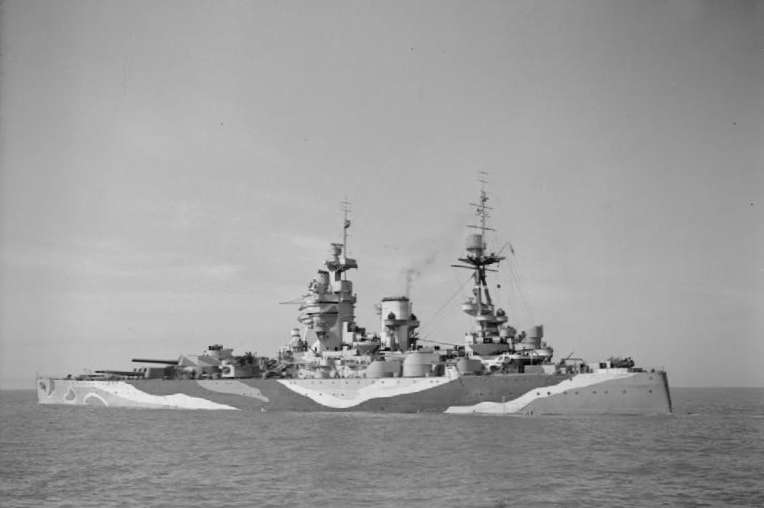
Battleships
HMS Rodney Helped to Sink the Bismarck
May 7, 2024 No Comments
HMS Rodney was a British battleship commissioned in 1927, known for her distinctive design featuring three triple 16-inch gun turrets.
Advertisement
She played a pivotal role during World War II, most notably in the sinking of the German battleship Bismarck in May 1941, a key victory for the Royal Navy.
After extensive service throughout the war, including support during the Normandy landings, HMS Rodney was decommissioned and scrapped in 1948, marking the end of her distinguished naval career.
Design of HMS Rodney
HMS Rodney was constructed under the constraints of the Washington Naval Treaty of 1922, a pivotal agreement among leading naval powers to prevent an arms race by limiting naval construction and battleship tonnage. This treaty significantly shaped Rodney’s design, leading to a vessel that prioritized firepower within a restricted displacement limit.
Read More That Time the Prinz Eugen Collided With the Light Cruiser Leipzig
Rodney’s most distinctive feature was its armament layout, with all main guns located forward of the superstructure—a design necessitated by the treaty’s tonnage limitations. Specifically, HMS Rodney was equipped with nine 16-inch guns arranged in three triple turrets. This configuration allowed for a shorter and thus lighter armored citadel, which was crucial for staying within displacement limits. However, the forward-heavy design led to several issues, including poor seaworthiness in rough weather and significant stress on the ship’s bow, which affected its structural integrity over time.
 The unique silhouette of HMS Rodney.
The unique silhouette of HMS Rodney.
Advertisement
In terms of secondary armament, Rodney carried twelve 6-inch guns, which were positioned along the sides of the ship to provide broadside fire. This was complemented by a variety of smaller-caliber anti-aircraft guns, which were upgraded throughout her service life to adapt to the evolving aerial threats of the World War II era. The anti-aircraft suite initially included eight 4-inch guns and eight 2-pounder guns, but these were augmented by additional 20mm Oerlikons by the war’s end.
Beyond her armaments, Rodney was noteworthy for incorporating advanced naval technology. Her propulsion system consisted of two sets of steam turbines driving two shafts, capable of producing a top speed of 23 knots—modest by the standards of the fastest battleships of her time, but sufficient for the roles she was expected to fulfill. The ship was also equipped with facilities for aircraft, including a catapult for launching and a hangar for storage, emphasizing the increasing recognition of aircraft as crucial elements of naval strategy.
Read More The Turret Explosion on the USS Iowa
Rodney’s armor was another critical aspect of her design. She featured a main belt of up to 14 inches of armor, with the most vital areas, such as the gun turrets and the conning tower, protected by up to 16 inches of steel. This comprehensive protective scheme was designed to withstand hits from the largest caliber guns then in service.
Advertisement
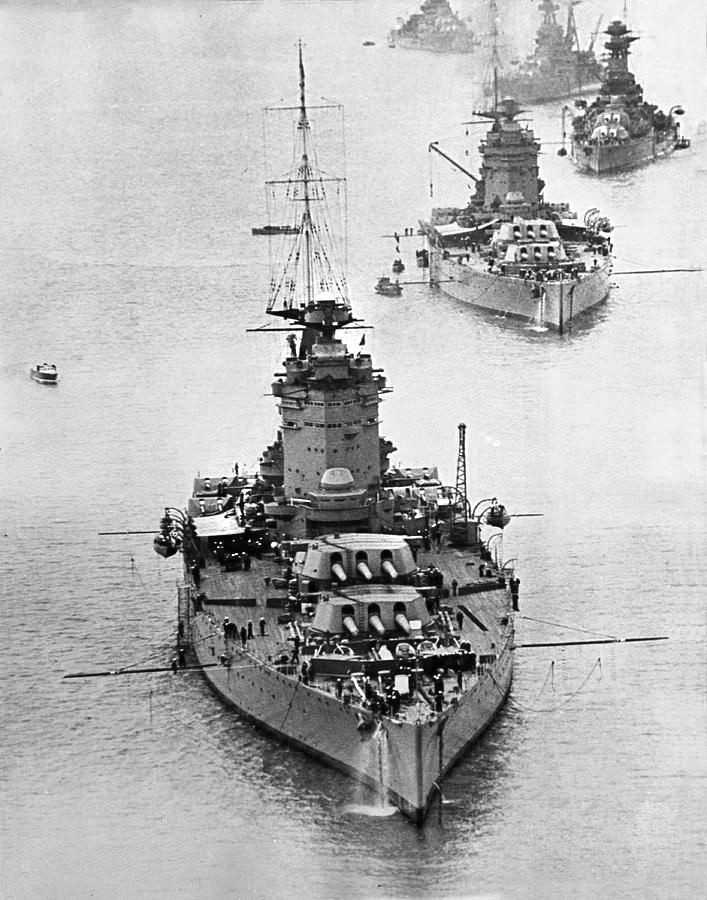 HMS Rodney following her sister ship HMS Nelson.
HMS Rodney following her sister ship HMS Nelson.
Advertisement
However, the very innovations that made HMS Rodney formidable also contributed to her limitations. The all-forward gun arrangement, while maximizing firepower for her displacement, resulted in handling difficulties and a less effective distribution of armament for certain tactical scenarios, such as engaging multiple surface targets simultaneously across a broad arc. Moreover, the ship’s machinery was complex and often unreliable, leading to mechanical issues that plagued her throughout her career.
HMS Rodney had a length of 710 feet (216 meters), a beam of 106 feet (32 meters), and a draught of 31 feet (9.5 meters). The ship’s displacement was approximately 33,730 tons when standard, and could increase up to about 38,000 tons when fully loaded.
Read More The USS Texas ‘Sank’ Herself on D-Day
HMS Rodney was built by Cammell Laird in Birkenhead, England. The keel for the ship was laid down on December 28, 1922. She was launched on December 17, 1925, and subsequently commissioned into service with the Royal Navy on November 10, 1927.
The Hunt for the Bismarck
The pursuit of the German battleship Bismarck in May 1941 is a textbook example of naval strategy and inter-service cooperation under exigent circumstances. The chase began when Bismarck, accompanied by the heavy cruiser Prinz Eugen, left the port of Gotenhafen (now Gdynia, Poland) and headed towards the Atlantic Ocean, aiming to intercept and destroy Allied convoys. This mission was part of Operation Rheinübung, designed to disrupt the Allied transatlantic supply line that was crucial for Britain’s sustenance during the war.
Advertisement
On May 22, Bismarck was sighted by Swedish reconnaissance aircraft, and her position was reported to the British naval command. This triggered an immediate and large-scale response from the Royal Navy, which mobilized several units to track down and engage the Bismarck before she could reach the Atlantic shipping lanes. The British fleet, scattered across various ports and duties, had to coordinate swiftly and effectively, drawing upon resources from across the naval spectrum.
Read More The USS Minneapolis Had a Bow Made From Coconut Trees
HMS Hood and the newly commissioned HMS Prince of Wales were tasked with intercepting Bismarck and Prinz Eugen in the Denmark Strait, a vital maritime passage between Greenland and Iceland. On May 24, during the Battle of the Denmark Strait, Bismarck engaged and sank HMS Hood with a salvo that detonated the ship’s ammunition magazines, resulting in a catastrophic explosion. The loss of HMS Hood, with only three survivors from her crew of 1,418, was a profound shock to the British public and the Royal Navy. It also intensified the urgency to find and destroy Bismarck.
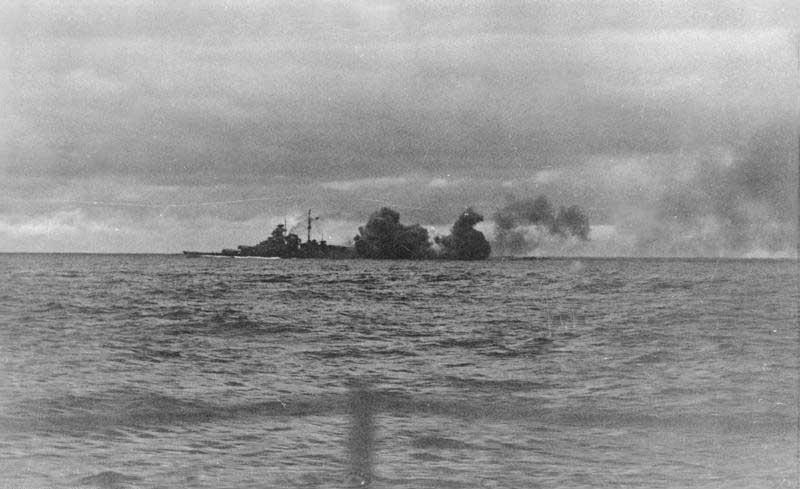 The Bismarck firing during The Battle of the Denmark Strait.
The Bismarck firing during The Battle of the Denmark Strait.
Following the sinking of Hood, Bismarck briefly engaged HMS Prince of Wales but managed to escape largely unscathed. The German ship then headed southward toward occupied France for repairs, as damage sustained during the engagement had caused a fuel leak. British forces, however, remained in relentless pursuit. Air reconnaissance and signals intelligence played crucial roles in this phase; Bismarck’s position was frequently updated through intercepted communications and aerial sightings.
The breakthrough came when aircraft from HMS Ark Royal, an aircraft carrier that had been urgently called into the chase, launched a series of torpedo attacks. One of the torpedoes successfully jammed Bismarck’s rudder and steering mechanisms, leaving her unable to maneuver effectively. This pivotal moment drastically reduced her tactical options and left her vulnerable to a direct naval confrontation.
Read More Fort Funston had 16-inch Battleship Guns
By now, HMS Rodney, which had been rerouted from her escort duties in the Atlantic, along with HMS King George V, closed in on the crippled Bismarck. These battleships, along with cruisers and destroyers, formed a formidable group that prepared to confront the disabled but still formidable German battleship. This set the stage for the final engagement, which would decisively end the threat posed by Bismarck to Allied naval operations in the Atlantic.
HMS Rodney Engages the Bismarck
The final battle between HMS Rodney, HMS King George V, and the crippled Bismarck took place on the morning of May 27, 1941. This confrontation was not merely a skirmish but a decisive showdown that would mark a turning point in the Battle of the Atlantic. Here’s an in-depth look at the naval engagement that led to the sinking of Bismarck.
 HMS Rodney firing her main guns during her battle with the Bismarck.
HMS Rodney firing her main guns during her battle with the Bismarck.
The battle commenced when British forces, having successfully cornered the Bismarck due to her inability to maneuver, approached to engage. HMS Rodney and HMS King George V were at the forefront, supported by cruisers and destroyers, including HMS Norfolk and HMS Dorsetshire. The British ships were determined to ensure that Bismarck did not escape to reach the safety of French ports.
Rodney and King George V opened fire from a distance of approximately 12 miles (19 km). The initial goal was to maximize damage while minimizing the effective return fire from Bismarck, whose gunnery was still formidable despite her compromised maneuverability. HMS Rodney, in particular, was in a position to utilize her powerful 16-inch guns effectively, firing broadsides that would eventually play a critical role in the outcome of the battle.
As the range closed, Rodney’s gunfire became increasingly accurate and devastating. Her shells targeted Bismarck’s superstructure, aiming to disable her command capabilities and gun turrets. The strategy was to disable the ship’s operational effectiveness before moving in closer to finalize the assault. HMS King George V complemented Rodney’s assault by engaging Bismarck with similar heavy gunfire, systematically dismantling the German battleship’s defenses and contributing to the cumulative damage.
The British ships maneuvered around Bismarck, creating a crossfire situation that overwhelmed the German crew and caused significant structural damage. Bismarck’s return fire was sporadic and increasingly ineffective as her main battery was disabled and her fire control systems were destroyed. The relentless British bombardment not only hammered Bismarck’s armor but also caused fires and secondary explosions within the ship.
Read More The Longest-Range Naval Hit – The Record Belongs to Two Ships
In the latter stages of the battle, after hours of continuous shelling had significantly weakened Bismarck’s structural integrity and resistance, the British ships employed torpedoes to hasten the end. HMS Rodney launched torpedoes at close range, an unusual tactic for a battleship, which underscored the desperate nature of the engagement. The torpedoes caused further flooding in Bismarck’s already listing hull, exacerbating the damage inflicted by the main guns.
 HMS Dorsetshire picks up sailors from the Bismarck. These were the lucky few.
HMS Dorsetshire picks up sailors from the Bismarck. These were the lucky few.
As Bismarck’s condition deteriorated, her crew’s ability to fight back was almost completely neutralized. However, the ship did not immediately sink, leading HMS Dorsetshire to deliver the coup de grâce with torpedoes that finally caused Bismarck to capsize and sink.
Later Operational History
After the pivotal battle with the Bismarck in May 1941, HMS Rodney continued to serve actively in the Royal Navy during World War II, participating in several key operations and playing various roles across different theaters of the war.
Read More S-130 – The Last Remaining German E-Boat
Post-Bismarck, Rodney returned to her duties in the Atlantic, where she was primarily involved in escorting convoys. The threat of German U-boats was ever-present, and Rodney’s role was crucial in deterring attacks on these vital supply routes between North America and Britain. Her presence in convoys served as a strong deterrent against potential surface raiders and submarines.
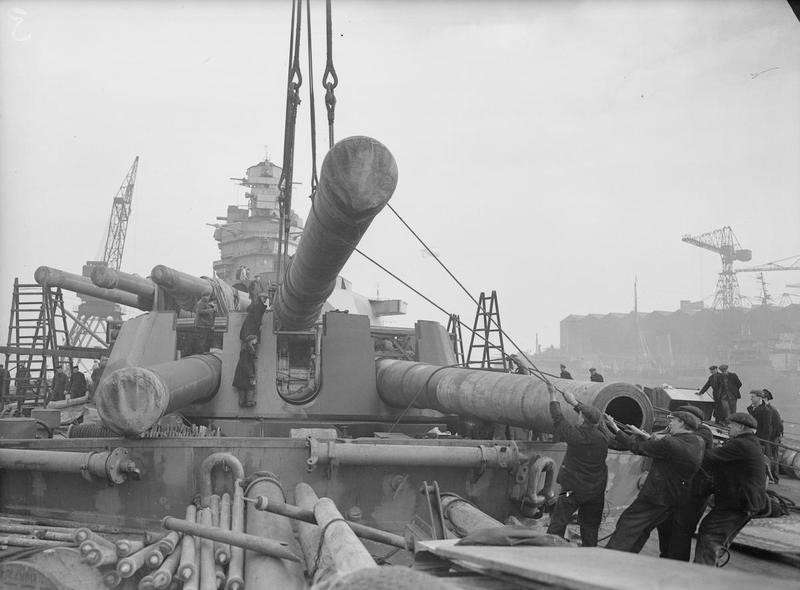 HMS Rodney having new 16 inch guns fitted, 1942.
HMS Rodney having new 16 inch guns fitted, 1942.
In November 1942, Rodney was involved in Operation Torch, the Allied invasion of North Africa. Her task was to provide naval gunfire support during the landings. Rodney bombarded targets at Casablanca, contributing significantly to the Allied efforts to secure a foothold in Vichy French-controlled Morocco. This operation was crucial for opening up a new front in the war against the Axis powers.
As the Allies shifted focus to the Italian Campaign in 1943, Rodney was called upon to support amphibious operations in the Mediterranean. She participated in the invasion of Sicily (Operation Husky) in July 1943, providing offshore bombardment to assist the advancing Allied troops. Her guns were effective against German and Italian defensive positions, clearing the way for troop movements inland.
Read More That Time the USS Wisconsin Collided With a Destroyer
Rodney’s most significant engagement after her battles in the Mediterranean was during the Normandy Landings in June 1944. As part of Operation Neptune, the naval component of Operation Overlord, Rodney provided gunfire support during the assault on the beaches. Her 16-inch guns were instrumental in destroying German fortifications and strongpoints along the coast, which greatly facilitated the landing of Allied forces on D-Day.
 HMS Rodney firing her guns on D-Day.
HMS Rodney firing her guns on D-Day.
After the Normandy campaign, Rodney continued her service in the Home Fleet. She was primarily stationed in the UK waters, ready to respond to any German naval threats. However, her operational role was reduced due to her aging condition and the mechanical wear she had sustained during her extensive wartime service.
Decommissioning of HMS Rodney
After World War II, HMS Rodney, like many battleships of her era, became increasingly obsolete due to the rapid advancements in naval technology and strategy, particularly the rise of air power and more modern, faster warships. By the end of the war, Rodney had seen extensive service and was showing signs of significant wear and tear. Her design, very powerful in the interwar period, was outdated in the new context of naval warfare.
Read More USS New Jersey is America’s Most Decorated Battleship
In the immediate post-war period, HMS Rodney remained in service with the British Royal Navy but was largely inactive. Her role shifted away from frontline duties due to the changing nature of naval warfare and the advent of newer ships. During this time, she was mainly used for training purposes and as accommodation ship, her days of active deployment long behind her.
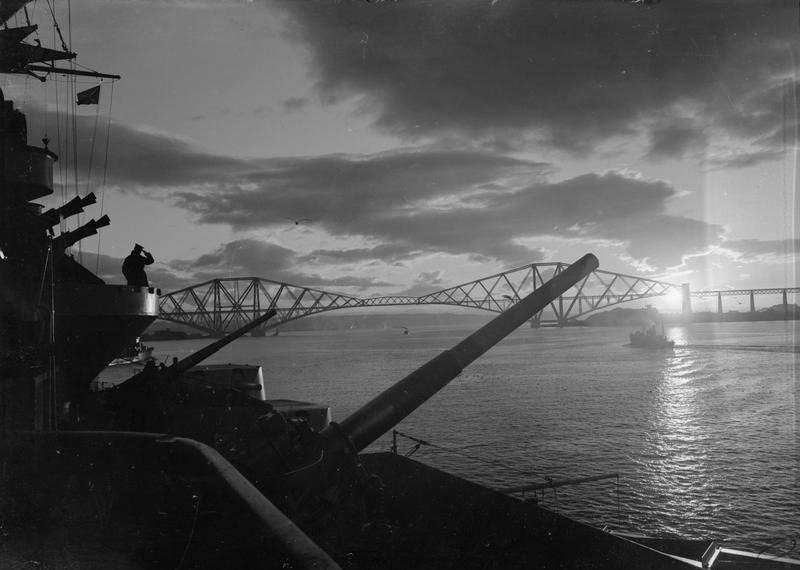 HMS Rodney in the Firth of Forth, October 1940.
HMS Rodney in the Firth of Forth, October 1940.
HMS Rodney was decommissioned from active service in 1947. By this time, the Royal Navy was undergoing significant reductions and reorganization, focusing on modernizing its fleet to better fit the post-war strategic environment. The cost of maintaining and upgrading older ships like Rodney, both in terms of finance and technology, was not justifiable.
In 1948, Rodney was sold for scrap, marking the end of her operational life. She was broken up at Inverkeithing, Scotland, by the shipbreaking company Thomas Ward. Her scrapping was part of a broader pattern in which many older battleships were dismantled in the years following World War II, as navies around the world shifted their focus towards aircraft carriers, submarines, and other more modern vessels.
News
The Hanging Temple: China’s 1,500-Year-Old Cliffside Marvel of Faith and Engineering
The Hanging Temple: China’s 1,500-Year-Old Cliffside Marvel of Faith and Engineering Perched precariously on the cliffs of Mount Heng in Shanxi Province, China, the Hanging Temple, also known as Xuankong Temple, Hengshan Hanging Temple, or Hanging Monastery, is an architectural…
The Willendorf Venus: A 30,000-Year-Old Masterpiece Reveals Astonishing Secrets
The Willendorf Venus: A 30,000-Year-Old Masterpiece Reveals Astonishing Secrets The “Willendorf Venus” stands as one of the most revered archaeological treasures from the Upper Paleolithic era. Discovered in 1908 by scientist Johann Veran near Willendorf, Austria, this small yet profound…
Unveiling the Maya: Hallucinogens and Rituals Beneath the Yucatán Ball Courts
Unveiling the Maya: Hallucinogens and Rituals Beneath the Yucatán Ball Courts New archaeological research has uncovered intriguing insights into the ritual practices of the ancient Maya civilization. The focus of this study is a ceremonial offering found beneath the sediment…
Uncovering the Oldest Agricultural Machine: The Threshing Sledge’s Neolithic Origins
Uncovering the Oldest Agricultural Machine: The Threshing Sledge’s Neolithic Origins The history of agricultural innovation is a fascinating journey that spans thousands of years, and one of the earliest known agricultural machines is the threshing sledge. Recently, a groundbreaking study…
Nara’s Ancient Sword: A 1,600-Year-Old Protector Against Evil Spirits
Nara’s Ancient Sword: A 1,600-Year-Old Protector Against Evil Spirits In a remarkable discovery that has captured the attention of archaeologists and historians alike, a 7.5-foot-long iron sword was unearthed from a 1,600-year-old burial mound in Nara, Japan. This oversized weapon,…
The Inflatable Plane, Dropped Behind the Lines for Downed Pilots
Experimental The Inflatable Plane, Dropped Behind the Lines for Downed Pilots The Inflatoplane from Goodyear was an unconventional aircraft developed by the Goodyear Aircraft Company, a branch of the renowned Goodyear Tire and Rubber Company, also famed for the Goodyear…
End of content
No more pages to load











